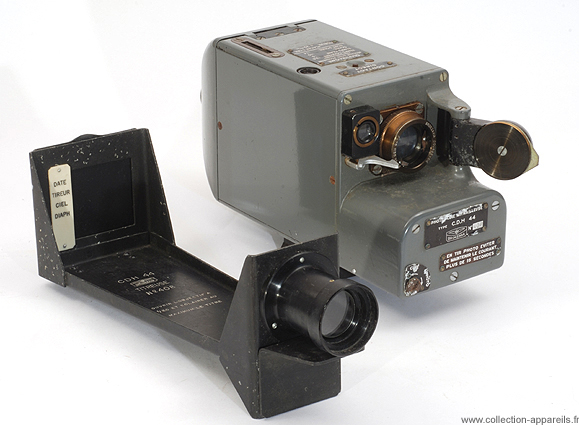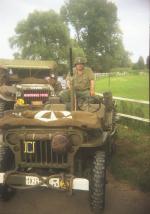|
Bronzavia CDH 44 |
Manufactured or assembled in France from 1944 to (After) 1944.
Index of rarity in France: Rare (among non-specialized garage sales)
Inventory number: 10490
See the complete technical specifications
Chronology of cameras Bronzavia
 |
| Inhaler Mask Bronzavia 1939 |
Bronzavia was a company specialized in the manufacturing of aviation equipment, including individual pilot gear providing oxygen and heating (1939), carburetors (for the Potez 63-11 aircraft), gas generators (1943), and more.
At least one patent filed by Bronzavia is found in the field of photography. This is Patent No. 820,091, published in 1937, concerning improvements made to focal-plane shutter cameras, particularly those used for aerial photography. The diagrams show a resemblance to the Type 70 cine-machine gun.

En 1938, the newspaper "L'Instantané" mentions "The Bronzavia camera, lightweight, handheld, with 3 lenses instantly interchangeable with focal lengths of 65, 100, and 160 mm, respectively." This may indeed refer to the Type 10.
The Nazi occupation is a dark period for the company, as its management committed to collaboration. Part of the equipment is relocated to Germany.
 |
|
| 1941 Information and Propaganda Bulletin (The location of the factory is not specified). | |
 |
 |
| Der Deutsche Wegleiter für Paris 1941 | Ads from april 1944 |
As the liberation approached, the company became a target of the Resistance.

| The F.F.I. Operation in One Week (Rafales Journal, July 1944) The information below was gathered from enemy sources. This makes it even more valuable. At the Bronzavia Factories Around 7:30 PM, a group of about fifty "terrorists" forcibly entered the said factories through the gates on Chemin des Alouettes and Chemin de Grange-Rouge, just as the maintenance and supervisory staff were preparing to leave. These "terrorists," armed with submachine guns, initially incapacitated the five guards of the factory, as well as three requisitioned individuals assigned to guard a transformer. They then gathered in the factory hall around twenty employees, along with the guards and requisitioned individuals, whom they bound and held at gunpoint. Meanwhile, a number of "terrorists" compelled an employee to accompany them to the workshops, where they placed the explosive devices they had with them. They planted one device at each engine, and by 10:40 PM, 67 explosions had already occurred, with the first occurring around 9:30 PM. |
At the Liberation, the company and its leaders faced sanctions.
 |
 |
| Bulletin Municipal Officiel de Paris from july 1945 | Le Populaire 1949 |
In 1946, Bronzavia had six factories and employed 4,000 people. There were six specialized departments, each with its own design office: radio department, engine power supply department, optics department (including photography), aeronautical boiler making department, general mechanical equipment on-board department, and electrical department. The CDH 44 cine-machine gun was mentioned among the flagship products, considered as a world-class product at the time.
 |
| The building in Courbevoie in 1937 |
The Courbevoie plant, established in 1932, closed between 1989 and 1994. The name disappeared during the same period, following the merger with Air Equipement, and after the name change to Lucas Aerospace Flight Control System.. __________
The Photo Ciné Mitrailleuse Bronzavia, type C.D.H. 44 (No. 408), was designed for the training of fighter pilots. This equipment was mounted on the aircraft through a quick support system that provided electrical power and shooting controls. However, it is equipped with a small optical viewfinder on the top and a small finger trigger. A selector allows choosing between single-shot and burst modes. The camera accepts eight meters of film in a special cartridge. The film is supported by a glass plate engraved with a target and records the numbers of a rotating counter.
The lens is marked as "Bronzavia Courbevoie F=75 F/3.5 No. 418."


Interesting links or bibliography :
Add a link or element of bibliography, a picture taken with this camera, a picture of box or an ads about this camera
Your photos taken with the same camera:
Cameras from Ebay France (Bronzavia) (Uploaded each 3 hours)








